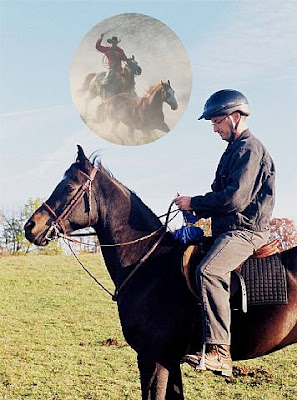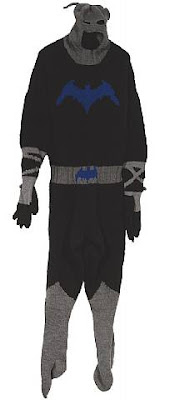by
John D. Spiak
Curator, The Arizona State University Art Museum
For centuries, knitting has been associated with the feminine -- from medieval portraits of the Virgin Mary beatifically purling to Grandma's treasured knit afghans. Arizona artist Mark Newport, however, views knitting and related domestic textile arts in quite a different way. For him, they are symbols for understanding masculinity and brute strength -- and the unlikely means by which he is able to create the iconic wardrobes of the superhero. Through methods traditionally associated with female cultural identity, Newport expresses his own ideas about male identity in American society in this, the very first museum solo exhibition of his work.
Born in 1964, Mark Newport grew up during the late 60s, when the after-school television viewing habits of many young American boys revolved around the world of Batman and other comic superheroes of the time. Like most children of his generation, the artist was hooked on these larger-than-life champions of right and good. In retrospect, he admits that he seemed to like the Batman-type heroes the best -- "the darkness, the loner, the ones that relied on gadgets more than invincible strength." He was less fond of Superman and patriotic-crusader types, gravitating instead to those who seemed a bit more human and vulnerable.
The world of comic books fascinated the artist, but not for the heroic storylines and awe-inspiring super powers reasons that they interested most kids of his generation. Newport was more interested in the drawing techniques of the artists who created these comics and in the visual language that existed within their pages. Their seductive power lay in the comic artist's creation of identity through appearance and suggested strength.
In his pre-teens, as with most young boys reaching that age, the artist's interests shifted. Fascination with the fantasy world of comics began to give way to that of human heroes embodied by the rock star and athletic stars of the baseball and football worlds. Collecting baseball and football cards soon became his new passion.
After receiving his Bachelor of Fine Arts degree from Kansas City Art Institute in 1986, Newport pursued a Master of Fine Arts at the School of the Art Institute of Chicago. It was there he became more familiar with and influenced by such feminist icons as writer Andrea Dworkin, artists Eva Hesse and Louise Bourgeois, and the Chicago-based Hairy Who, which was a primarily male dominated group of artists that first appeared in the early 1960s. He was developing his artistic voice at a time in which the art world was focused on multiculturalism and the backlash against the art-star filled, white male artist-driven world. Tuning into this, Newport began making abstract sculpture works examining issues of gender and male identity in an attempt to better understand the issues being discussed in the contemporary art scene at that time.
In 1994, returning to the icons with which he was familiar, he started using imagery connected with the sports heroes emblazoned on trading cards. He began to embroider on and then bead the individual cards, first those of sports figures, then on Desert Storm, pin-up and porn star trading cards. Newport explains that "[t]he trading cards were more of a decorative critique of maleness using a beading process. They dealt with gender issues, but were very abstract in concept. [I]t was an exploration of the outer skins or shells of identity, void of the knowledge of the inner workings." Eventually he began working the process upon comic book covers, leading to his Comic Book Quilts and Samplers series.
When Newport felt the trading cards and comic book series had reached a certain peak, he began to look for different forms with which to work, which coincided with the artist being in a different psychological place in his life. He was now a young father of two and began to examine his role in his own children's lives. According to Newport, his own father always said he was Superman, reflecting most children's belief that their parents can do anything. Questions about how others, especially his children, perceived him drew the artist's interest, compelling him to develop new approaches that not only looked at outward manifestations of gender identity, but ones that explored the very core of that identity.
It was at that point Newport began to find his current artistic voice, which reaches back to a time that was influential in the development of his own masculinity, to the visuals and identities he first referenced as "hero." As a youngster, Newport had learned to knit from his grandmother but he had forgotten how. Over a three-year period, with the help of his wife and pattern instructions he found on the Internet, the artist relearned the art of knitting. He began to use this rediscovered knowledge to create the hand-knit superhero costumes that are part of ASU Art Museum's current exhibition, "Super Heroics."
"Turning the superhero inside out is a way for me to present an understanding of masculinity," says Newport. "Superheroes suggest strength, but knitting them or covering them with embroidery provides a softness that is contradictory to their image." Like the mild-mannered exteriors of superhero alter-egos Bruce Wayne and Clark Kent, who morph into Batman and Superman respectively, these are not the trappings of rough-and-tough, super-powered individuals, but rather of Everyman, the common male who plays his role in life with integrity, gentility and reliable consistency -- characteristics of masculinity often undervalued in our society.
The works in the exhibition are familiar to the viewer, drawing upon classic figures of pop cultural superhero identities from Superman and Batman to lesser known, more contemporary figures such as the Escapist (from Michael Chabon's novel, The Amazing Adventures of Kavalier and Clay ), as well as more autobiographical created figures as Sweaterman (2005) and Sweaterman: Cable (2005). These outer shells, which tie in to Newport's early body of work, now take on full human scale, yet are stripped of their references to tough inner personae, ripped body muscles and superhuman physical strength usually associated with the characters donning them. Instead, Newport's superhero costumes hang limply in the gallery, allowing the viewer to psychologically create the complex identities that would fill such a costume, or perhaps fantasize about one's own body filling that void. Essentially, Newport's costumes are skins waiting to be brought to life.
Newport's newest work, a series of ink jet prints created from photographic self-portraits, emphasize the paralyzing lack of confidence in one's ability to have an appreciable affect on the outside world. Works like He Could Help (2005), ssk (2005), and Knitting a Forcefield 1 (2005) all represent the protective shields we place around ourselves, our barriers against personal involvement when others are in need of help. Known in sociological terms as the Bystander Effect, this phenomenon is defined as the belief that individuals do not get involved in helping others because they feel that someone else is better suited to respond, the undertaking may be too dangerous, or that others will take care of the situation.
Newport's art compels us to re-examine the nature of a super-heroic act within the context of contemporary society. For Newport, it does not involve stopping a speeding train, preventing a natural disaster, or saving the world from crime; rather, it consists of acting upon everyday opportunities to be present for others, at the right time with the right gesture, through which one becomes a hero in someone else's eyes.












